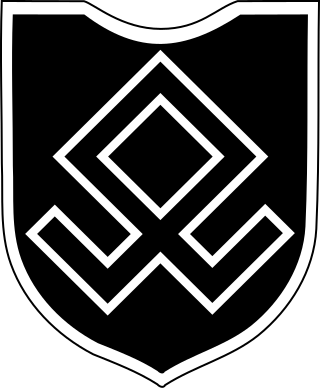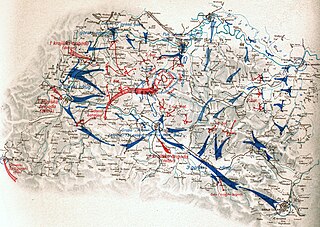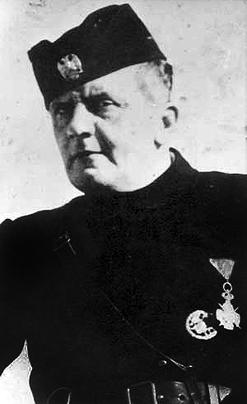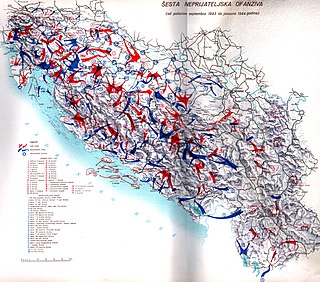
Case White, also known as the Fourth Enemy Offensive, was a combined Axis strategic offensive launched against the Yugoslav Partisans throughout occupied Yugoslavia during World War II. It was one of the most significant confrontations of World War II in Yugoslavia. The offensive took place in early 1943, between 20 January and mid-to-late March. The Axis operation prompted the Partisan Supreme Command to enact its plans to drive toward eastern Herzegovina, Sandžak and Montenegro.

The Yugoslav Partisans, or the National Liberation Army, officially the National Liberation Army and Partisan Detachments of Yugoslavia, was the communist-led anti-fascist resistance to the Axis powers in occupied Yugoslavia during World War II. Led by Josip Broz Tito, the Partisans are considered to be Europe's most effective anti-Axis resistance movement during World War II.

Case Black, also known as the Fifth Enemy Offensive in Yugoslav historiography and often identified with its final phase, the Battle of the Sutjeska was a joint attack by the Axis taking place from 15 May to 16 June 1943, which aimed to destroy the main Yugoslav Partisan force, near the Sutjeska river in south-eastern Bosnia. The failure of the offensive marked a turning point for Yugoslavia during World War II. It was also the last major German-Italian joint operation against the partisans.

Operation Little Saturn was a Red Army offensive on the Eastern Front of World War II that led to battles in Don and Chir rivers region in German-occupied Soviet Union territory in 16–30 December 1942.
The 2nd Panzer Army was a German armoured formation during World War II, formed from the 2nd Panzer Group on October 5, 1941.

The 13th Waffen Mountain Division of the SS Handschar was a mountain infantry division of the Waffen-SS, an armed branch of the German Nazi Party that served alongside but was never formally part of the Wehrmacht during World War II. At the post-war Nuremberg trials, the Waffen-SS was declared to be a criminal organisation due to its major involvement in war crimes and crimes against humanity. From March to December 1944, the division fought a counter-insurgency campaign against communist-led Yugoslav Partisan resistance forces in the Independent State of Croatia, a fascist puppet state of Germany that encompassed almost all of modern-day Croatia, all of modern-day Bosnia and Herzegovina and parts of Serbia.

Operation Rösselsprung was a combined airborne and ground assault by the German XV Mountain Corps and collaborationist forces on the Supreme Headquarters of the Yugoslav Partisans in the Bosnian town of Drvar in the Independent State of Croatia during World War II. It was launched 25 May 1944, with the goal of capturing or killing Partisan leader Marshal Josip Broz Tito and destroying the headquarters, support facilities and co-located Allied military missions. It is associated with the Seventh Enemy Offensive in Yugoslav history, forming part of the Seven Enemy Offensives historiographical framework. The airborne assault itself is also known as the Raid on Drvar.

The 7th SS Volunteer Mountain Division "Prinz Eugen", initially named the SS-Volunteer Division Prinz Eugen, was a mountain infantry division of the Waffen-SS, an armed branch of the German Nazi Party that served alongside but was never formally part of the Wehrmacht during World War II. At the post-war Nuremberg trials, the Waffen-SS was declared to be a criminal organisation due to its major involvement in war crimes and crimes against humanity. From 1942 to 1945, the division fought a counter-insurgency campaign against communist-led Yugoslav Partisan resistance forces in occupied Yugoslavia. It was formed in 1941 from both Reich Germans and Volksdeutsche – ethnic German volunteers and conscripts from the Banat, Independent State of Croatia, Hungary and Romania. The division surrendered on 11 May 1945 to Yugoslav Partisan forces.

Operation Southeast Croatia was a large-scale German-led counter-insurgency operation conducted in the southeastern parts of the Independent State of Croatia during World War II. It was the first of two German-led operations targeting mainly Yugoslav Partisans in eastern Bosnia between 15 January and 4 February 1942. Several days after the conclusion of Operation Southeast Croatia, a follow-up operation known as Operation Ozren was carried out between the Bosna and Spreča rivers. Both operations also involved Croatian Home Guard and Italian troops and are associated with what is known as the Second Enemy Offensive in post-war Yugoslav historiography. The Second Enemy Offensive forms part of the Seven Enemy Offensives framework in Yugoslav historiography.

Operation Trio was the first large-scale joint German-Italian counter-insurgency operation of World War II conducted in the Independent State of Croatia (NDH), which included modern-day Bosnia and Herzegovina. It was carried out in two phases within eastern Bosnia from 20 April to 13 May 1942, with Ustaše militia and Croatian Home Guard forces taking part on the Axis side. The aim of the operation was to target all insurgents between Sarajevo and the Drina river in eastern Bosnia. These included the communist-led Yugoslav Partisans and Serb nationalist Chetniks. Differentiating between the rank and file of the two insurgent factions was difficult, as even the communist-led insurgent groups consisted mainly of Serb peasants who had little understanding of the political aims of their leaders.

After the Kingdom of Yugoslavia was invaded by the Axis powers during World War II, all of Bosnia was ceded to the newly created Independent State of Croatia. Axis rule in Bosnia led to widespread persecution and mass-killings of native undesirables and anti-fascists. Many Serbs themselves took up arms and joined the Chetniks, a Serb nationalist and royalist resistance movement that conducted ineffective guerrilla warfare against the occupying Nazi forces. On 12 October 1941 a group of 108 notable Muslim citizens of Sarajevo signed the Resolution of Sarajevo Muslims by which they condemned the persecution of Serbs organized by Ustaše, made distinction between Muslims who participated in such persecutions and whole Muslim population, presented information about the persecutions of Muslims by Serbs and requested security for all citizens of the country, regardless of their identity.
The Seven Enemy Offensives is a group name used in Yugoslav historiography to refer to seven major Axis military operations undertaken during World War II in Yugoslavia against the Yugoslav Partisans.

World War II in the Kingdom of Yugoslavia began on 6 April 1941, when the country was invaded and swiftly conquered by Axis forces and partitioned among Germany, Italy, Hungary, Bulgaria and their client regimes. Shortly after Germany attacked the USSR on 22 June 1941, the communist-led republican Yugoslav Partisans, on orders from Moscow, launched a guerrilla liberation war fighting against the Axis forces and their locally established puppet regimes, including the Axis-allied Independent State of Croatia (NDH) and the Government of National Salvation in the German-occupied territory of Serbia. This was dubbed the National Liberation War and Socialist Revolution in post-war Yugoslav communist historiography. Simultaneously, a multi-side civil war was waged between the Yugoslav communist Partisans, the Serbian royalist Chetniks, the Axis-allied Croatian Ustaše and Home Guard, Serbian Volunteer Corps and State Guard, Slovene Home Guard, as well as Nazi-allied Russian Protective Corps troops.

The Kozara Offensive, also known as Operation Ksaver was a large-scale German-led counter-insurgency operation against the Yugoslav Partisans in the Bosnian mountain region of Kozara in the Independent State of Croatia during World War II. It was launched on 10 June 1942, with the goal to encircle and destroy the Partisans who were operating in the Kozara mountain region near Banja Luka, which threatened German access to the Belgrade-Zagreb railway.

Dobroslav Jevđević was a Bosnian Serb politician and self-appointed Chetnik commander in the Herzegovina region of the Axis-occupied Kingdom of Yugoslavia during World War II. He was a member of the interwar Chetnik Association and the Organisation of Yugoslav Nationalists, a Yugoslav National Party member of the National Assembly, and a leader of the opposition to King Alexander between 1929 and 1934. The following year, he became the propaganda chief for the Yugoslav government.

Axis forces were involved in counter-insurgency operations against the various resistance movements during World War II.

The 369th (Croatian) Infantry Division was a legionary division of the German Army (Wehrmacht) during World War II.

The 373rd (Croatian) Infantry Division was a division of the German Army during World War II. It was formed in June 1943 using a brigade from the Home Guard of the Independent State of Croatia with the addition of a German cadre. The division was commanded by Germans down to battalion and even company level in nearly all cases, and was commonly referred to as a "legionnaire division". Originally formed with the intention of service on the Eastern Front, it was used instead for anti-Partisan operations in the territory of the NDH until the end of the war. It fought mainly in the western areas of the NDH, and was involved in the attempt to kill or capture the leader of the Partisans, Josip Broz Tito, in May 1944. Severely depleted by desertion, the division withdrew towards the Reich border in the early months of 1945, eventually surrendering to the Partisans on 10 May 1945 near Brežice in modern-day Slovenia.

Vojislav Lukačević was a Serbian Chetnik commander in the Kingdom of Yugoslavia during World War II. At the outbreak of war, he held the rank of captain of the reserves in the Royal Yugoslav Army.

The 16th Panzer Division was a formation of the German Army in World War II. It was formed in November 1940 from the 16th Infantry Division. It took part in Operation Barbarossa, the invasion of the Soviet Union in June 1941, operating in the southern sector of the Eastern Front. After the Soviet offensive in November 1942 the division was trapped in Stalingrad, where it surrendered in February 1943. A new 16th Panzer Division was formed in 1943 and sent to Italy where it was part of the unsuccessful German defense against the Allied invasion of Italy. Sent back to the Eastern Front in November 1943 the division once more saw action in the southern sector, taking part in the relief operation of the Korsun-Cherkassy Pocket and being part of the Kamenets-Podolsky pocket. It eventually surrendered to Soviet and American forces in Czechoslovakia in May 1945.


















